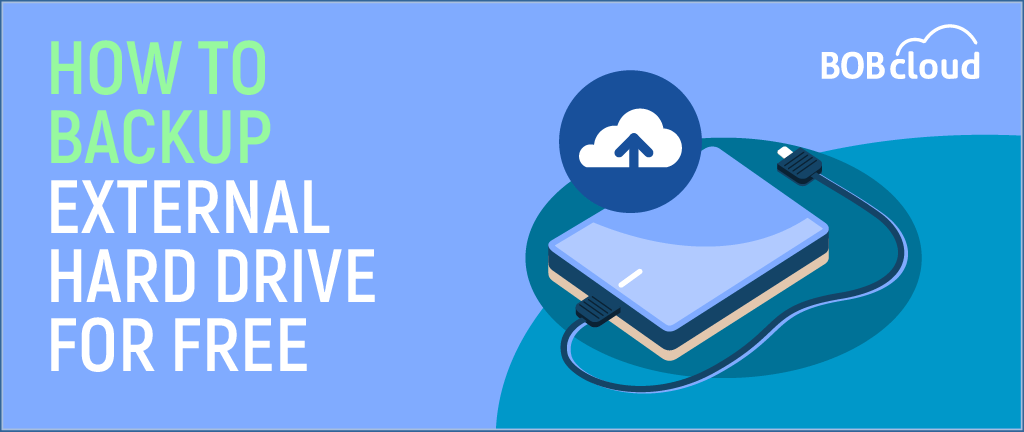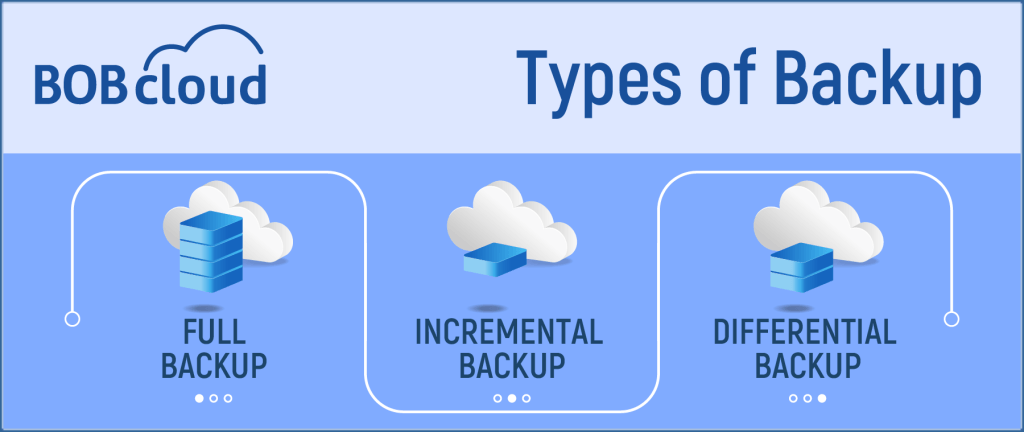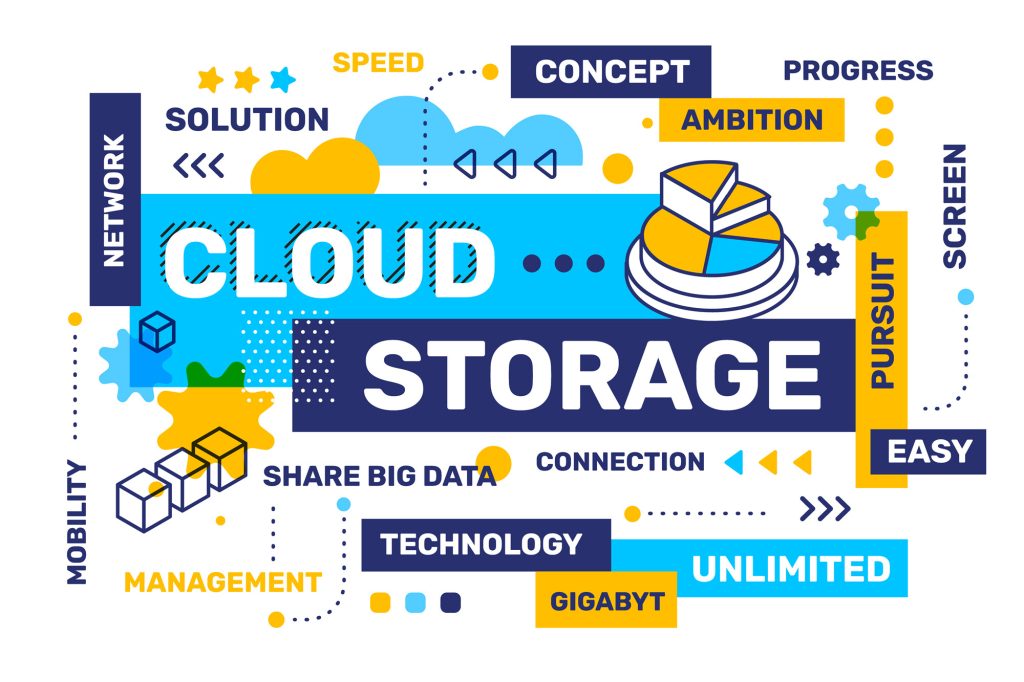How Do I Backup an External Hard Drive For FREE?
Table of Contents
Do you have an external hard drive that you can take with you? You may have sensitive company data and presentations you show customers, or you may bring your holiday photos and videos to Grannie’s.
Anything can happen to that drive, meaning your data is irretrievably lost or stolen. Daily reported problems are theft of the drive, data corruption and hardware failure from bumps and shock, stolen data, and a ransom attack on the data, rendering it unreadable.
It is straightforward to back up your external drives and disks; we cover the options in this article.


How Do I Backup My External Drive?
You can backup your external drive to your main PC’s hard drive or to another external drive if you have one. You can take Windows backup to external drive and keep it safe for backup purposes.
You can also back up to the cloud. Cloud-based solutions might be too expensive to host your backups, especially if you plan to save large files from your external hard drive. However, most cloud storage providers provide many free plans. Your definition of many data might be small compared to the free storage you can get.
Our experience tells us it is never worth taking the risk with your data. It isn’t if but when you will lose your data.
Benefits of Backing Up Your External Hard Drive
- Peace of mind: Having your data safely backed up provides peace of mind, as it assures you that if you happen to lose an irreplaceable image or an important file, unpredictable circumstances won’t cause you to lose it
- Faster disaster recovery: If by any chance your external hard drive fails, gets corrupted, or is stolen, you would get to have backups from which to restore your data, thus restricting the downtime and frustrations that would otherwise arise.
- Remote access (Cloud Backup): This feature allows you to restore any document, picture, or video from any PC, tablet, or smartphone connected to the Internet. It is a fantastic feature; if you need to access data from the computer, you can use your phone.
Manual Backup vs. Automatic Backup:
There are two ways to perform backups: manually or automatically.
Manual backup involves copying your files from your external drive to your backup location (another drive or cloud storage). Taking complete control over the process requires more effort and discipline to ensure regular backups.
Automatic backup uses software to schedule and perform backups automatically. Choosing this option is more convenient, as it eliminates the risk of forgetting to back up your data. However, you will need to select and configure backup software.
Experts typically recommend automatic backups to ensure your data is backed up regularly without relying on memory.
Local Backup vs. Cloud Backup:
Local and cloud backups are two main approaches on how to backup external hard drive. Each has its advantages and disadvantages:
| Backup Method | Pros | Cons |
|---|---|---|
| Local Backup (External Drive) |
|
|
| Cloud Backup |
|
|
Choosing the Correct Backup Software
You need to consider the following when selecting backup software for your external hard drive:
- Backup Location: Most backup software providers link their data centres to cloud storage. However, you should always keep an offline copy of your data in a physical hard drive in case a cloud outage occurs.
- Cost: Some backup software may charge a premium fee to store your data. Depending on your preferred backup software, you must factor in recurring costs (or one-time payments).
- Backup Speed: Quicker backups make getting a safe copy of your external hard drive onto a server easy.
- Ease of Recovery: Your preferred backup software should offer a complete and straightforward restore process to recover stored data, images, and photos to your external hard drive. Some software options may not be efficient if you need to recover all files from your last backup on their servers.
Choosing the correct method depends on your needs:
- Local backup is a good option if you prioritise speed and control and are okay with managing another drive.
- Cloud backup might be better if you value remote access and automatic backups and aren’t worried about limited storage (initially).
Consider a combination of local and cloud backups for maximum protection, especially for critical data.
How to Create an Effective Backup Schedule
Your backups should be automatic and should based on a schedule. Automated backups are more reliable and eliminate human error in storing copies of your data from an external hard drive.
Automate your backups with a schedule tailored to your needs. Automated backups are more reliable and eliminate human error when storing data from your external hard drive. Here are vital things to consider when setting a schedule:
- Frequency: How often you back up depends on factors like the size and value of your data and the resources required to store it. We recommend daily or weekly backups for sensitive data or large data volumes.
- Scalability: Your backup plan should adapt as your data grows. Consider if your chosen backup software and storage solution can accommodate future needs.
- Security: Focus on data security during transit and at rest. Your chosen backup destination should prioritise security measures to keep your data safe from unauthorised access.
How to Backup Your External Hard Drive in 3 Ways
There are various options when you decide which backup software to use and how to deploy it.
Method #1: How To Backup External Hard Drive to Another External Hard Drive
Of course, External hard drives are the first and foremost primary source of data storage devices.
External hard drives are ideal for local backup devices. Users can access data at any time without much trouble. You can also transfer data from one storage device to another to make extra backup copies.
Data is backed up either through a manual backup or an automated backup process.
Option #1: Manual Backup Process using Windows Explorer
How do you back up files manually to your external drive? Follow the below step-by-step instructions.
- Plug both external hard drives into your computer.
- The source and destination drive will show up on your computer system.
- Select the source files you want to back up from the source drive.
- Drag and drop or copy and paste the files from the source to the destination.
Option #2: Use Xcopy or RoboCopy to Backup External Hard Drive
Using command-line tools such as Xcopy and Robocopy to back up your external hard to your backup location will simplify the process and remove most human error.
Xcopy and Robocopy are potent tools that come as built-in software in Windows. Compared to Xcopy, Robocopy offers more features, such as control during the copy, including hidden files, compression, backup-only modified files, and encryption.
You must have some basic technical skills to utilise these tools effectively. However, you can access both tools through the Windows command prompt without installing additional software.
Option #3: Using Third Party Backup Software
Third-party backup applications can make backing up your data even more straightforward.
Great free software applications like Microsoft OneDrive, DropBox or Google Drive exist within a specified storage limit.
This backup software can sync all the data from one external hard drive to the other. It can also perform full, incremental, or differential backup processes for your data, such as files and folders.
Method #2: Backup to the Cloud Storage
Cloud storage is the most reliable location for storing data. It has been a lucrative business for companies such as Google, which prides itself on “Google Drive” as a cloud storage service. Typically, cloud computing services aim to provide user comfort for the masses, and the service provider manages them.
Physical data centres run the virtual storage space for Cloud data storage. These data centres have various servers, giving users good data storage space. These services, which allow the user to store data online on a platform, are cloud storage services.
In a cloud storage service, the provider offers users limited space, which users can increase with a paid plan. Through this space, users can upload data from anywhere, whether on computers or mobile devices.
Cloud storage’s foremost usefulness is that it is digital and will keep track of data more than physical storage devices do in the event of data loss due to hardware depreciation. To this end, cloud storage is cost-efficient; therefore, there is no need to incur costly storage devices, so you don’t need to buy expensive external hard drives to maintain data.
Let us take external hard drives as an example. Cloud data backup first transfers the data from an external hard drive to a personal computer, making it mathematically impossible. That is why, if you intend to do so, you can send the data from your personal computer to one of the popular cloud storage services on the World Wide Web.
Method #3: Using Third Party Devices
While the above methods are commonplace, other options still exist. You can use USB flash drives or NAS (Network Attached Storage). These methods are less efficient than the ones mentioned above because you need to remember to back up.
USB flash drives can act as external hard drives. Due to their compact size, they can be cost-effective and more accessible to carry around. However, USB’s storage space is limited compared to an external hard drive.
Therefore, while a USB flash drive can serve as a secondary storage device, it may only be able to store some of the critical data you may want. But if you wish only to back up specific data, then a USB is the way to go because it is portable and cheap.
On the other hand, users may try out Network-Attached Storage (NAS). Users can connect through an Ethernet connection. This way, the user can share data without having an internet connection.
The stored data is easily accessible to multiple people. However, installing a NAS can complicate and incur costs, but it may reduce the possibility of data loss and allow for offsite data management.
Tips on How to Secure Your Backup Data
Security is essential to consider while performing an external hard drive backup. You must implement encryption and password protection for all backups to strengthen the integrity and safety of stored information. Data admins can implement effective encryption and password-key protection along with the following steps:
- Security key rotation – consider switching access keys to your data and prevent unauthorised access in the event of a breach. Key rotation isn’t a standard feature and is usually available in high-end cloud storage or NAS systems.
- Asymmetric encryption – you can improve data security with asymmetric encryption of backed-up data. Two keys are needed to access data secured through asymmetric encryption. Anyone who seeks access to data backed up from an external hard drive or other devices must possess the public and private keys.
Best Practices for External Hard Drive Maintenance
Engaging best practices to maintain your external storage involves way more than regular hard drive backups. Use the tips below to keep your storage devices and prevent data loss after an external hard drive backup:
Tips to Prolong the Lifespan of Your External Hard Drive
- Be gentle! – if you travel with your external disk, consider keeping it in a foam-lined box. None of us likes to bash around, and your disk is the same.
- Don’t use it in extreme weather – extreme heat and humidity can damage an external hard drive.
- Handle carefully – improper handling of your external hard drive can result in irreversible data loss. Always place the hard drive on a flat, balanced surface.
Preventive Measures to Avoid Data Loss
- Engage a disaster recovery plan – The plan outlines steps you should take if potential data loss is imminent on any of your storage devices.
- Apply common preventive steps – You can follow common steps to prevent data loss on your external hard drive:
- Storing your external hard drive in a safe environment free from contact with dust or liquids
- Saving data from your hard drive backup in different locations
- Preventing unauthorised access to backed-up data through software encryption.
- Install a reliable antivirus or firewall – Data admins can install functional antivirus software to prevent malicious access to data stored on an external backup device. Firewalls installed on backup hard drives can help prevent unauthorised breaches of essential data.
- Use an emergency power supply source – A power surge or outage could disrupt the smooth flow of data to a backup device. Use an emergency power backup device like an Uninterruptible Power Supply (UPS) to complete the storage of your data image. You can easily prevent data loss during a backup with a UPS connected to your computer or transfer device.
Conclusion
Backing up data from an external hard drive is an intelligent way to manage stored information and facilitate recovery. Data backups from an external hard drive help protect against hardware failures, malicious attacks, disasters, human mistakes, power surges or outages.
Storing data securely in two or more backup locations provides vital safeguards to keep your information accessible.
The correct data backup architecture makes restoring essential information after a security breach, natural disaster, or accident more straightforward. Following the steps outlined in this guide will give you everything you need to back up your external hard drive for free.
You can use these tips to keep your data security high. Security measures described above can also help you prevent unauthorised access to vital information stored on your external drives.
Common Frequently Asked Questions
Why Is My Backup External Hard Drive Suddenly So Slow for Mac?
The slowness in backing up the external hard drive on your Mac could be due to a problem with the software or hardware, like a faulty USB connection, outdated firmware, fragmented files, resource-intensive background processes, and large and duplicate files taking up space on the disk. It may also link to the MacOS update. Ensure the safety of your files and seek professional consultation if the problem remains unresolved.
How To Backup External Hard Drive Before Formatting
Connect your external hard drive to your computer. You can manually copy the files to another location or use backup software. If manually copying, select all files and folders, then copy them to another external hard drive or your computer’s internal hard drive.
Ensure you correctly back up all your files to the new location before formatting. If you use backup software, always keep your files safe by following the instructions. For more detailed information, refer to this article.



